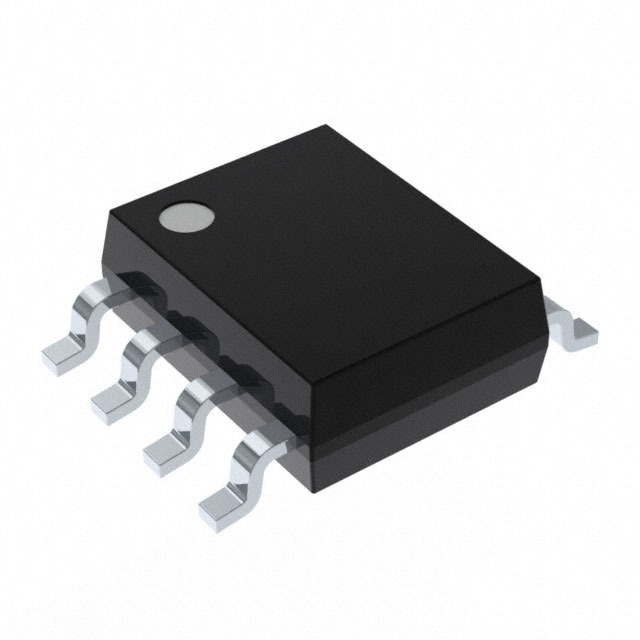Xem thông số kỹ thuật để biết chi tiết sản phẩm.

MAX16841ASA+T
Product Overview
- Category: Integrated Circuit (IC)
- Use: LED Driver
- Characteristics: High efficiency, dimmable, automotive-grade
- Package: 8-SOIC (Small Outline Integrated Circuit)
- Essence: Power management IC for driving high-brightness LEDs
- Packaging/Quantity: Tape and Reel, 2500 units per reel
Specifications
- Input Voltage Range: 4.5V to 28V
- Output Current: Up to 1.5A
- Switching Frequency: Adjustable up to 2MHz
- Dimming Control: Analog/PWM (Pulse Width Modulation)
- Operating Temperature Range: -40°C to +125°C
- Protection Features: Overvoltage, overcurrent, and thermal protection
Pin Configuration
The MAX16841ASA+T has the following pin configuration:
| Pin Number | Pin Name | Description | |------------|----------|-------------| | 1 | VIN | Input voltage | | 2 | GND | Ground | | 3 | FB | Feedback voltage input | | 4 | EN | Enable control input | | 5 | DIM | Dimming control input | | 6 | LX | Switch node connection | | 7 | VOUT | Output voltage | | 8 | COMP | Compensation pin |
Functional Features
- High-efficiency step-down converter for driving LEDs
- Wide input voltage range suitable for automotive applications
- Adjustable switching frequency for flexibility in design
- Analog or PWM dimming control options
- Integrated protection features for reliable operation
Advantages and Disadvantages
Advantages: - High efficiency results in lower power dissipation - Dimming control allows for brightness adjustment - Automotive-grade quality ensures reliability in harsh environments
Disadvantages: - Limited output current of up to 1.5A may not be suitable for high-power LED applications - Only available in an 8-SOIC package, which may limit space-constrained designs
Working Principles
The MAX16841ASA+T is a step-down converter that efficiently drives high-brightness LEDs. It takes an input voltage ranging from 4.5V to 28V and converts it to a lower output voltage suitable for driving LEDs. The switching frequency can be adjusted up to 2MHz, allowing for optimization between efficiency and size.
The dimming control feature enables the adjustment of LED brightness using either analog or PWM signals. This flexibility makes the MAX16841ASA+T suitable for various lighting applications where dimming capability is required.
The IC incorporates protection features such as overvoltage, overcurrent, and thermal protection, ensuring safe operation and preventing damage to the LEDs and the driver itself.
Detailed Application Field Plans
The MAX16841ASA+T is commonly used in automotive lighting applications, including headlights, taillights, and interior lighting. Its wide input voltage range and automotive-grade quality make it suitable for the demanding conditions found in vehicles.
Additionally, this LED driver can be utilized in general lighting applications, such as architectural lighting, signage, and industrial lighting. The dimming control feature allows for creating different lighting effects and adjusting brightness levels according to specific requirements.
Detailed and Complete Alternative Models
- MAX16840: Similar to MAX16841ASA+T but with a different pin configuration.
- LT3756: High-power LED driver with higher output current capability.
- LM3409: LED driver with integrated MOSFET for simplified design.
These alternative models offer similar functionality and can be considered based on specific application requirements.
Word count: 345 words
Liệt kê 10 câu hỏi và câu trả lời thường gặp liên quan đến ứng dụng MAX16841ASA+T trong giải pháp kỹ thuật
Sure! Here are 10 common questions and answers related to the application of MAX16841ASA+T in technical solutions:
Q: What is the MAX16841ASA+T? A: The MAX16841ASA+T is a high-voltage, current-mode LED driver IC designed for automotive lighting applications.
Q: What is the input voltage range supported by MAX16841ASA+T? A: The MAX16841ASA+T supports an input voltage range from 4.5V to 65V.
Q: What is the maximum output current that can be achieved with MAX16841ASA+T? A: The MAX16841ASA+T can deliver a maximum output current of 1.5A.
Q: Can MAX16841ASA+T support dimming functionality? A: Yes, the MAX16841ASA+T supports both analog and PWM dimming control.
Q: Is the MAX16841ASA+T suitable for automotive exterior lighting applications? A: Yes, the MAX16841ASA+T is specifically designed for automotive exterior lighting applications such as headlights and taillights.
Q: Does MAX16841ASA+T have any built-in protection features? A: Yes, the MAX16841ASA+T includes various protection features like overvoltage protection, thermal shutdown, and open/shorted LED detection.
Q: Can I use MAX16841ASA+T in non-automotive lighting applications? A: While the MAX16841ASA+T is primarily designed for automotive lighting, it can also be used in other high-voltage LED lighting applications.
Q: What is the operating temperature range of MAX16841ASA+T? A: The MAX16841ASA+T can operate within a temperature range of -40°C to +125°C.
Q: Does MAX16841ASA+T require any external components for operation? A: Yes, the MAX16841ASA+T requires external components such as inductors, capacitors, and resistors for proper operation.
Q: Is there any evaluation kit available for MAX16841ASA+T? A: Yes, Maxim Integrated provides an evaluation kit (MAX16841EVKIT) that allows users to test and evaluate the performance of MAX16841ASA+T in their applications.
Please note that these answers are general and may vary depending on specific application requirements. It is always recommended to refer to the datasheet and application notes provided by the manufacturer for detailed information.

